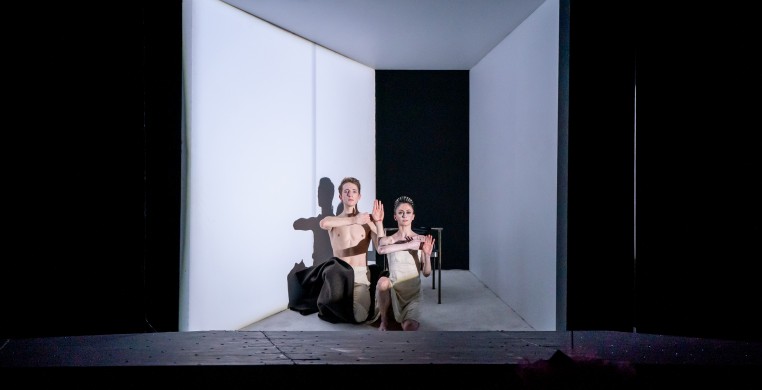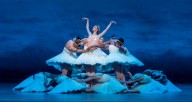John Neumeier’s surrealist psychological take on Hans Christian Andersen’s classic tale, “The Little Mermaid,” written in 1836, pays close attention to the 19th-century author’s cosmology. “Be careful what you wish for” could easily be the subtitle for both cautionary tales.
But while Neumeier expands upon much in the original plot, one of his many strokes of creative genius in this production, which premiered with The Royal Danish Ballet in 2005, is adding the character of the author, Andersen, as “The Poet,” and placing him at the center of his own story and of the choreographer’s storytelling.
Fantasy meets reality in the character of “The Poet, portrayed by Stefan Goncalvez, who incorporates his mastery of mime with his sleight of hand as a sublime dance artist. The Poet acts as our tour guide through a story that sails blithely across the borders of time, place, dream, and reality.
We first encounter The Poet, furtive and all angles, as he enters the scene of his own story. He wears a stovepipe black hat that practically swallows his head, a long black mourning coat, black necktie, and black pants. Quirky arms and legs inch him forward. He stops to cross himself mourning a loss. The Poet sheds a tear and watches it fall into the sea, taking the form of a mermaid, a figment of his imagination.
Moving cat-like, he skitters toward a giant conch shell and holds it to his ear, listening to the sound of the sea. As he listens to the conch shell, so do we, and when The Poet dives into the sea, so do we. He swims, his body undulating with the current of water, his hand waving, fish-like, floating, his body in weightless navigation.
A corps of sea anemones swims by, ushering in The Little Mermaid (Victoria Jaiani). Her shimmering bodice of sparkling scales defines the torso of a woman, while yards of flowing silken blue fabric trace the hips and footless tail of a fish. She moves as if swimming, the movement of dancer’s feet completely obscured by the fabric.
The Mermaid becomes a character in the story The Poet is writing and with whom he ultimately falls in love. His fictional invention of the Mermaid takes on a life of her own, a phenomenon to which many fiction writers fall victim. The Poet, always lurking in the background, becomes an observer of the very story he is writing, and it is ultimately through his eyes that we see it.
In a certain sense, Neumeier’s “The Little Mermaid” is a hall of mirrors, a story within a story within a story, that unfolds with the inevitability of the hero’s tragic flaw—the Little Mermaid’s yearning to ascend to become human so that she may achieve “salvation;” the Poet’s to rewrite the story of unrequited love, but alas, Fate intervenes.
The Little Mermaid’s yearning to join the world of human beings is so desperate, she seeks out The Sea Witch (Yoshihisa Arai) making a bargain with a devil: she will get her human legs, and she will dance, but every step she takes will be wrought with excruciating pain. Their scene, reminiscent of Kabuki theater, creates a great opportunity for a light show from Hades, with the tympani section of the orchestra kicking up a storm at sea.
Meanwhile, on board in a comic moment, the Prince, practicing his golfing chip shot on deck, pitches the golf ball into the sea, leans over the rail to watch the golf ball sink, and falls in after it. The Little Mermaid, trying to save The Prince from drowning, swims with his lifeless body and deposits him on the shore. She revives him with a kiss, but when he opens his eyes, it is the Princess, in the uniform of a school girl, whom he sees, thinking it is she who has saved him and not The Little Mermaid.
Music and haunting silence are central to the dramatic impact of the production. Lera Auerbach’s evocative score, resonating from the orchestra pit by the wonderful Lyric Opera Orchestra under the direction of Scott Speck, paints every scene with nuanced tone throughout the production. The music, like the lighting and set design, are in constant dialogue with the dancing.
In Neumeier’s “The Little Mermaid,” dance, an art form that exists outside the language of words, is perfectly suited to tell this story of two coexisting worlds—the submerged underwater world of the subconscious mind, and the the world of appearances on the surface. Whether above water or below, we are on dry land only in the characters’ memories.
We feel this story in our hearts and in our bodies with gut-wrenching clarity, not only because of Neumeier’s skill in every aspect of the production—choreography, sets, costumes and lighting!!—but because of the Joffrey dancers.
In the interpretive hands of The Joffrey Ballet Chicago, known for the theatrical depth and versatile acting skills of its dancers, “The Little Mermaid” elevates the storytelling to Greek tragic proportions.
Make no mistake, this is not your typical “feel-good” night out at the ballet with all the spectacle of dazzling technical footwork, gravity- defying leaps, and romantic pas de deux. All that great ballet stuff is there, but it’s in service of a story that won’t let its audience just “sit back, relax, and enjoy the show.” This Little Mermaid holds you in her grip from dénouement to epilogue.
In addition, Neumeier incorporates an eclectic choreographic palette that includes many dance genres—classical and contemporary ballet, modern dance, jazz, tap, Broadway, vaudeville—that meld with Neumeier’s own unique movement invention. His creative imagination seems to grow, like Jack’s beanstalk, toward the heavens with each decade of his prolific career.
Each character is meticulously crafted in movement that defines their personalities as three-dimensional people with motivations, behavior, and relationships on multiple levels, some subtle and some volcanic.
Of particular note are the performances of the main characters on opening night. Victoria Jaiani’s extraordinary artistry and dramatic versatility have given us heroines of breathtaking beauty and heart-wrenching depth over a career with The Joffrey that spans two decades. Her portrayal of The Little Mermaid ascends to the performance of a lifetime. She brings the combination of her character’s naïveté and the pathos of her unrequited passion for The Prince to the heights of human despair with her character’s crippling disability. Neumeier paints her pathetic figure literally into a box where her beautiful soul and gorgeous body become imprisoned by the arthritic horror and pain that are every dancer’s nightmare.
The nuanced rhythm and energy shifts in stage action contribute to keeping the audience poised for surprise, from the lyrical beauty of the underwater sequences to the Sea Witch’s explosive sea storms, to the satirical humor of Society onboard ship. A healthy sprinkling of Noh Drama and Kabuki theatre mix in to keep the audience as well as the dancers on our toes.
A stunning climactic moment unites The Mermaid, The Poet, The Prince, and the Princess as they intertwine bodies and spirits, slipping across and into each other in a quartet that weaves arms, legs and spines across each other until individuals are no longer distinguishable. In this transcendent scene, The Poet’s melts into his own creation.
In the Epilogue, there is hope, as story and storyteller unite, liberating each other and uniting The Poet and his Mermaid into an eternity of the mind and imagination.
Neumeier, a Milwaukee native and artistic director of the Hamburg Ballet, trained and performed with Bentley Stone and Walter Camryn in Chicago and performed here with Ruth Page and Sybil Shearer. His immense artistic achievement in “The Little Mermaid” underscores his stature as one of the great choreographic innovators of our time.
------------------------
The Little Mermaid runs April 19-30 at the Civic Opera House, Chicago. For tickets and information, go online to seechicagodance.com, and click on "See Dance."


